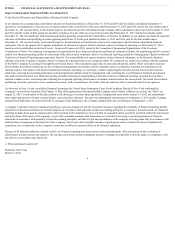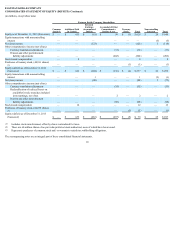Kodak 2015 Annual Report Download - page 15
Download and view the complete annual report
Please find page 15 of the 2015 Kodak annual report below. You can navigate through the pages in the report by either clicking on the pages listed below, or by using the keyword search tool below to find specific information within the annual report.
FOREIGN CURRENCY
For most subsidiaries and branches outside the U.S., the local currency is the functional currency. The financial statements of these subsidiaries and branches are
translated into U.S. dollars as follows: assets and liabilities at year-end exchange rates; revenue, expenses and cash flows at average exchange rates; and
shareholders’ equity at historical exchange rates. For those subsidiaries for which the local currency is the functional currency, the resulting translation adjustment
is recorded as a component of Accumulated other comprehensive (loss) income in the accompanying Consolidated Statement of Financial Position. Translation
adjustments related to investments that are permanent in nature are not tax-effected.
For certain other subsidiaries and branches outside the U.S., operations are conducted primarily in U.S. dollars, which is therefore the functional currency.
Monetary assets and liabilities of these foreign subsidiaries and branches, which are recorded in local currency, are remeasured at year-end exchange rates, while
the related revenue, expense, and gain and loss accounts, which are recorded in local currency, are remeasured at average exchange rates. Non-monetary assets and
liabilities, and the related revenue, expense, and gain and loss accounts, are remeasured at historical exchange rates. Adjustments that result from the
remeasurement of the assets and liabilities of these subsidiaries are included in Other (charges) income, net in the accompanying Consolidated Statement of
Operations.
The effects of foreign currency transactions, including related hedging activities, are included in Other (charges) income, net, in the accompanying Consolidated
Statement of Operations.
Venezuela Currency
Kodak has accounted for the Venezuelan economy as highly inflationary since 2010. Accordingly, Kodak’s Venezuelan subsidiary uses the U.S. dollar as its
functional currency, and monetary assets and liabilities denominated in BsF generate income or expense for changes in value associated with foreign currency
exchange rate fluctuations against the U.S. dollar. Kodak’s Venezuelan subsidiary does not have ongoing trading activity.
The Venezuelan government has maintained currency controls and a fixed official exchange rate since 2003. The official exchange rate at December 31, 2015 and
2014 was 6.3 Venezuelan Bolivars Fuertes (“BsF”) to the U.S. dollar. In 2013, the Venezuelan government announced the creation of a complementary currency
exchange system, referred to as “SICAD 1.” SICAD 1 was determined by an auction process restricted to invited entities for designated uses. At December 31,
2014, the SICAD 1 exchange rate was 12.0 BsF to the U.S. Dollar. In 2014, the Venezuelan government created another currency exchange system known as
“SICAD 2,” indicating that all industry sectors and companies would be eligible to participate in SICAD 2. Transactions in SICAD 2 were regulated by the
Venezuelan Central Bank. Entities were required to submit applications to convert BsF to U.S. dollars under SICAD 2. The SICAD 2 exchange rate as of
December 31, 2014 was 49.99 BsF to the U.S. dollar.
Given increased uncertainty in Venezuela, Kodak adopted the SICAD 2 rate to remeasure BsF denominated monetary assets and liabilities of its Venezuelan
subsidiary to the U.S. dollar as of December 31, 2014. As a result of this change from the official exchange rate, Kodak recorded a charge of $16 million in other
(charges), income net in the fourth quarter of 2014.
In 2015, the Venezuelan government merged the SICAD 1 and SICAD 2 exchange mechanisms into a single mechanism called SICAD and introduced a new open
market system, “SIMADI.” The SIMADI market is intended to have a floating exchange rate determined by market participants. Kodak adopted the SIMADI rate
to remeasure BsF denominated monetary assets and liabilities of its Venezuelan subsidiary to the U.S. dollar as of March 31, 2015. The SIMADI exchange rate at
March 31, 2015 was 191.97 BsF to the U.S. dollar. As a result of the change from the SICAD 2 rate, Kodak recorded a charge of $2 million in other (charges),
income net in the first quarter of 2015. The SIMADI exchange rate as of December 31, 2015 was 198.7 BsF to the U.S. dollar.
As of December 31, 2015 and December 31, 2014, Kodak’s Venezuelan subsidiary had approximately $1 million and $2 million, respectively, of BsF denominated
net monetary assets, composed primarily of cash and cash equivalents.
CONCENTRATION OF CREDIT RISK
Financial instruments that potentially subject Kodak to significant concentrations of credit risk consist principally of cash and cash equivalents, receivables, and
derivative instruments. Kodak places its cash and cash equivalents with high-quality financial institutions and limits the amount of credit exposure to any one
institution. With respect to receivables, such receivables arise from sales to numerous customers in a variety of industries, markets, and geographies around the
world. Receivables arising from these sales are generally not collateralized. Kodak performs ongoing credit evaluations of its customers’ financial conditions, and
14
























